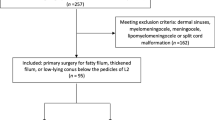Abstract
Purpose
This study aimed to determine the justification for routine postoperative MRI (POMR) following surgical release of tethered cord (TC) given that an MR, in this situation, mostly serves as a baseline and rarely has immediate clinical implications. Furthermore, later in the course of the disease, the presence of retethering is mostly assessed by clinical parameters, rather than imaging.
Methods
A single-center retrospective review of patients who underwent tethered cord release surgery between the years 1997 and 2009 at the Department of Pediatric Neurosurgery, Tel Aviv Medical Center, Israel was performed. Collected data including basis for diagnosis, pathology, associated clinical and radiologic findings, surgical procedure and outcome, postoperative follow-up and morbidities, and postoperative MRI findings were recorded and analyzed.
Results
One hundred forty patients operated upon between 1997 and 2009 for tethered cord syndrome were reviewed. Routine postoperative MR was performed in all cases 6–18 months after surgery. All cases were fully untethered. MR revealed relevant information in eight cases, two with residual dermoid, and six with significant terminal syrinx. None of these findings led to repeat surgery or special treatment. Retethering operations were performed in two cases in which retethering was diagnosed based on clinical evaluation.
Conclusions
Based on analysis of our series of 140 consecutive patients who all underwent POMR 6–18 months after TC release, we suggest that POMR as routine clinical practice is not justified for uncomplicated cases of TC release. In cases of high risk for retethering, or significant preoperative syrinx or dermoid, POMR is recommended to establish a baseline for future clinical follow-up.
Similar content being viewed by others
References
Ben-Sira L, Ponger P, Miller E, Beni-Adani L, Constantini S (2009) Low-risk lumbar skin stigmata in infants: the role of ultrasound screening. J Pediatr 155:864–869
Colak A, Pollack IF, Albright AL (1998) Recurrent tethering: a common long-term problem after lipomyelomeningocele repair. Pediatr Neurosurg 29:184–190
Emmez H, Guven C, Kurt G, Kardes O, Dogulu F, Baykaner K (2004) Terminal syringomyelia: is it as innocent as it seems?—Case report. Neurol Med Chir (Tokyo) 44:558–561
Erkan K, Unal F, Kiris T (1999) Terminal syringomyelia in association with the tethered cord syndrome. Neurosurgery 45:1351–1359, discussion 1359–1360
Gan YC, Sgouros S, Walsh AR, Hockley AD (2007) Diastematomyelia in children: treatment outcome and natural history of associated syringomyelia. Childs Nerv Syst 23:515–519
Gupta RK, Sharma A, Jena A, Tyagi G, Prakash B, Khushu S (1990) Magnetic resonance evaluation of spinal dysraphism in children. Childs Nerv Syst 6:161–165
Haro H, Komori H, Okawa A, Kawabata S, Shinomiya K (2004) Long-term outcomes of surgical treatment for tethered cord syndrome. J Spinal Disord Tech 17:16–20
Hsu AR, Hou LC, Veeravagu A, Barnes PD, Huhn SL (2009) Resolution of syringomyelia after release of tethered cord. Surg Neurol 72:657–661
Iskandar BJ, Oakes WJ, McLaughlin C, Osumi AK, Tien RD (1994) Terminal syringohydromyelia and occult spinal dysraphism. J Neurosurg 81:513–519
Kanev PM, Lemire RJ, Loeser JD, Berger MS (1990) Management and long-term follow-up review of children with lipomyelomeningocele, 1952–1987. J Neurosurg 73:48–52
Lew SM, Kothbauer KF (2007) Tethered cord syndrome: an updated review. Pediatr Neurosurg 43:236–248
Meltzer H, James HE, Trauner D, Katz R (1995) Syringomyelia of the distal spinal cord in children. Pediatr Neurosurg 22:248–250
Ng WH, Seow WT (2001) Tethered cord syndrome preceding syrinx formation—serial radiological documentation. Childs Nerv Syst 17:494–496
Ponger P, Ben-Sira L, Beni-Adani L, Steinbok P, Constantini S (2010) International survey on the management of skin stigmata and suspected tethered cord. Childs Nerv Syst 26:1719–1725
Sade B, Beni-Adani L, Ben-Sira L, Constantini S (2003) Progression of terminal syrinx in occult spina bifida after untethering. Childs Nerv Syst 19:106–108
Steinbok P, Garton HJ, Gupta N (2006) Occult tethered cord syndrome: a survey of practice patterns. J Neurosurg 104:309–313
Terai T, Henmi T, Kanematsu Y, Fujii K, Mishiro T, Sakai T, Sairyo K (2006) Adult onset tethered cord syndrome associated with intradural dermoid cyst. A case report. Spinal Cord 44:260–262
van der Meulen WD, Hoving EW, Staal-Schreinemacher A, Begeer JH (2002) Analysis of different treatment modalities of tethered cord syndrome. Childs Nerv Syst 18:513–517
Vernet O, O'Gorman AM, Farmer JP, McPhillips M, Montes JL (1996) Use of the prone position in the MRI evaluation of spinal cord retethering. Pediatr Neurosurg 25:286–294
Author information
Authors and Affiliations
Corresponding author
Rights and permissions
About this article
Cite this article
Halevi, P.D., Udayakumaran, S., Ben-Sira, L. et al. The value of postoperative MR in tethered cord: a review of 140 cases. Childs Nerv Syst 27, 2159–2162 (2011). https://doi.org/10.1007/s00381-011-1578-7
Received:
Accepted:
Published:
Issue Date:
DOI: https://doi.org/10.1007/s00381-011-1578-7




